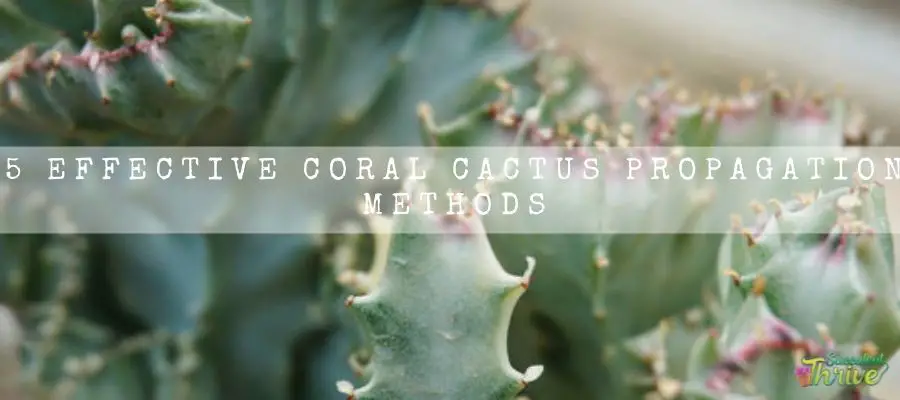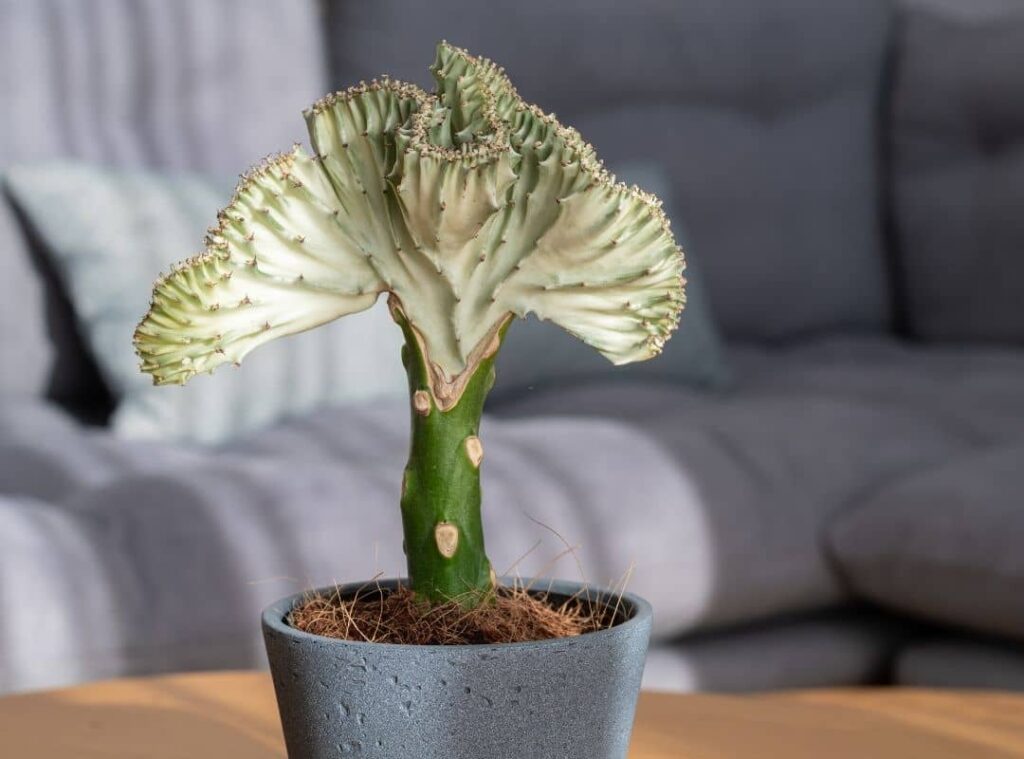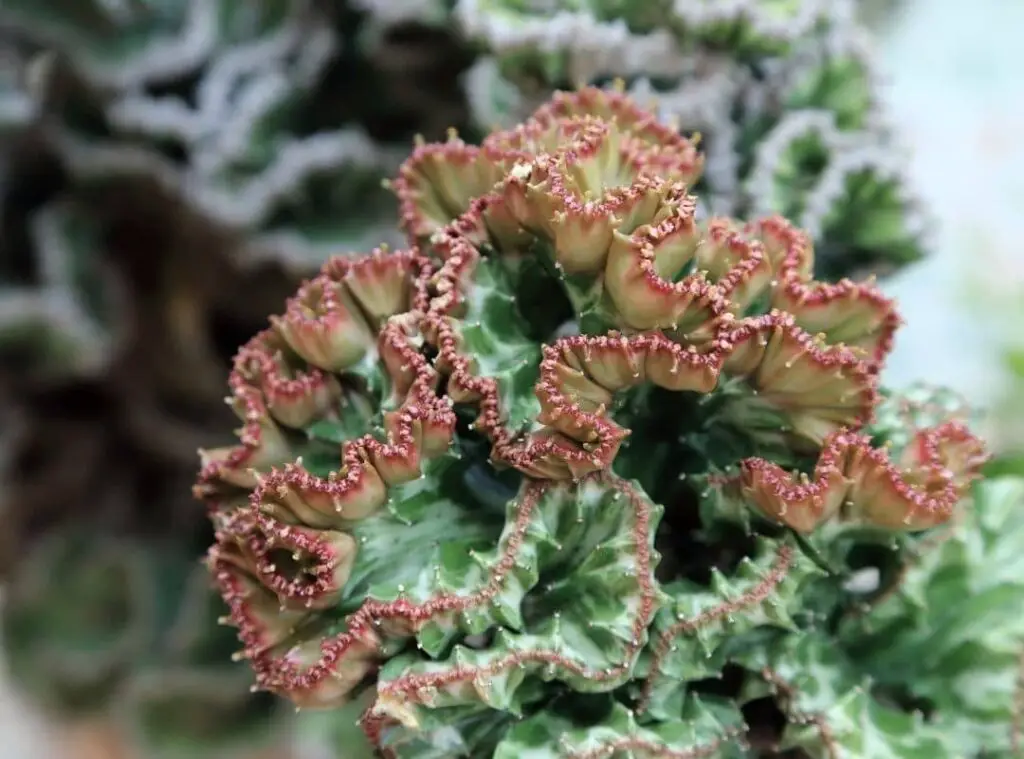As the name implies this cactus looks like a beautiful coral species. So I am sure you want to know effective coral cactus propagation methods.
You have come to the correct place. Let’s find out what you seek for.

What is coral cactus?
Coral cactus belong to genus Euphorbia. These are toxic plants for humans and for pets as well. Coral cactus is a combination of two varieties of Euphorbias.
Generally, it would be Euphorbia neriifolia which would be the base plant. It would look more like a cactus and consist of wider leaves which are oval shaped.
Having said that, you may also use other euphorbia species for the base plant.
The upper part of the graft would be most probably a crest from another plant. It could possibly be Euphorbia lacteal which usually have ripped leaves which resemble fan.
Once the whole graft comes together, it would tend to look like an unusual coral.
Coral cactus consist of a sap which is toxic, and it could even create severe allergies. Actually it could result in irritation in the skin as well as in your eyes.
Coral cactus propagation via Stem Cutting
You should ideally conduct propagation in summer which is their actively growing season.
Further keep in mind to protect yourself first by wearing all the protective gears so that you could safeguard yourself as they will release a sap which could be poisonous for you.
Hence, I recommend you wear a pair of goggles and gloves before starting interacting with the plant for any purpose.
To start off, you need to first choose a plant which has a healthy rootstock. Then, take a sharp clean sterile knife and make a cutting which has a V shape of the upper part of the plant.
Afterwards, you could trim off the stem part which is adjoining the branch. Do not forget to wash away the sap and best is to use cold water to do that.
You could dig the cuttings in a rooting hormone powder and wither them for a week or so which will allow them to develop callous.
Once they do, you could plant them in a soil mix which has excellent draining. I recommend moisturizing them and waiting for sometime so that they can start rooting in the soil.
Ensure that you locate the specimens in a warm and dry place. That would be quite beneficial for a faster root formation.
In fact, you could spot them forming roots within a couple of weeks’ time.
Coral cactus propagation via Offsets
You could simply separate the pups from the mother plant first. Next, dry them and grow them in a well-draining soil mix.
Do they produce seeds?
Coral cactus do produce seeds. Further you could even use their seeds to propagate them too. This is very rarely used though.
Can you root coral cactus in water?
You could propagate coral cactus in water. You simply have to obtain the cuttings and let them wither.
Next you may place those in a germination plate and locate them in a glass of water. However, you need to ensure that the stem cut touches the water.
If you leave the rest of your specimen to be in touch with water, it will lead to root rot. You could leave the specimen in a sunny place, and they will start to sprout.

How to treat after propagation
Sunlight requirement and temperature requirement
If you live in USDA zones 10-11, you could grow them outdoors. However, you need to bring them indoors If you live in zones apart from 10 and 11.
A temperature range of 60-85 degrees Fahrenheit would be perfect to grow these plants. intense heat levels should not ever reach the coral cactus.
You should ideally expose the newly propagated coral cactus for partial shade and after that only you need to slowly acclimate them to full sunlight. That will not give a shock to the plants.
When you grow them indoors, choose a spot which will allow the plants to get 3-5 hours of sunlight on a daily basis.
Not only that but also, you should keep rotating the plants so that the whole plant can absorb sunlight evenly.
Coral cactus are not frost hardy plants. They cannot withstand the temperatures which drop below 50 degrees Celsius.
As aforesaid they would prefer to grow in 60-85 degrees Fahrenheit. If there is any extreme colder weather condition you need to shift the plants indoors.
Water and humidity requirements
Watering the coral cactus is vital in terms of taking care of the propagated coral cactus well.
So, if you are uncertain whether you need to water these plants or not, best is to suspend doing it for a few days.
Having said that, coral cactus is not tolerant of drought conditions like the other cactus in general.
However, they do not prefer to be in waterlogged conditions also. If you expose them to moist conditions, it will cause rotting of the plants.
You could simply check whether the soil is dry by emphasizing the first four inches of the soil is dry. If you feel like it is dry, you could commence watering the plants.
Further you need to avoid watering the plant and instead water the soil and make sure that the excess moisture is draining through the draining holes.
If you spot your coral cactus is droopy or wilted, under watering could be the root cause of it. On the other hand, over watering could also be troublesome for the coral cactus.
If you expose the coral cactus roots to be in waterlogged conditions, that could make the plant susceptible for root rot.
Hence it is crucial that you water the plants only when their soil is dry only.
If we consider months such as spring and summer, you need to water them more often rather than what you do in winter.
During cooler months, they need only very minimal water to thrive. They could grow in high humidity levels, given that they get good air circulation.
You could grow them in green houses due to this factor. However, if you expose them to high humidity levels, you need to watch out for pests’ attacks such as powdery mildew.
Soil requirements for coral cactus
A cactus potting soil or a succulent soil mix would match these plants well. Alternatively, you could grow them in a well-draining and a gritty soil mix too.
These are not the types of plants which are choosy when it comes to the right ph. levels of the soil mix. However, It could be slightly acidic to slightly alkaline.
Fertilizer requirements of the coral cactus
You could consider feeding the coral cactus during spring and summer. To feed them, you could go ahead with a 10-10-10 liquid fertilizer.
However, you should dilute it to quarter strength and then apply it. In terms of frequency, you could feed them once every fortnight.
If you have grown them in a less soil amount, you could feed them even less.
Suspend feeding them during fall and winter since during these periods they will be literally on their relaxing mode and do not consume any of their energy.
Apart from that I do not encourage you to use slow-release fertilizers or granular fertilizers as they would cause foot burn of the coral cactus.

Related question
How do you root coral cactus cuttings?
You simply need to cut a V shape of the top part of the plant first. Next you could trim off the stem which adjoins the branch.
After that you should wash it with cold water so that you can get rid of the sap.
Next you could consider dipping the cut edges in a rooting hormone and ensure that it gets wither for a couple of weeks and develop callus.
How do you separate coral cactus pups?
First you need to dry the pups and only then you should plant them.
Ensure they are exposed to shade in their new growing spot. If we consider the coral cactus which grow in the wild, they will grow in clumps, and it is not essential to remove them.
Does coral cactus need sunlight?
Coral actus require full sunlight to partial sunlight to thrive well. You could grow them in full sunlight outdoors.
However, it would be even more appropriate if you could grow them in a spot where they can gain partial shade along with full sunlight particularly during mid afternoon times in summer.
That way you could protect the plants from sunburns.
Conclusion
Before winding this up, I hope this article was useful for you and trust you could improve your knowledge in conducting the propagation of the coral cactus properly.
You should be vigilant to practice the right aftercare tips also to have best results of the propagation process.
Read Next : Haworthia Cooperi Propagation Guide | 5 Effective Methods | Echeveria Perle Von Nurnberg Propagation | 5 Effective Methods | Sedeveria Lilac Mist Propagation | 3 Effective Methods For You |
